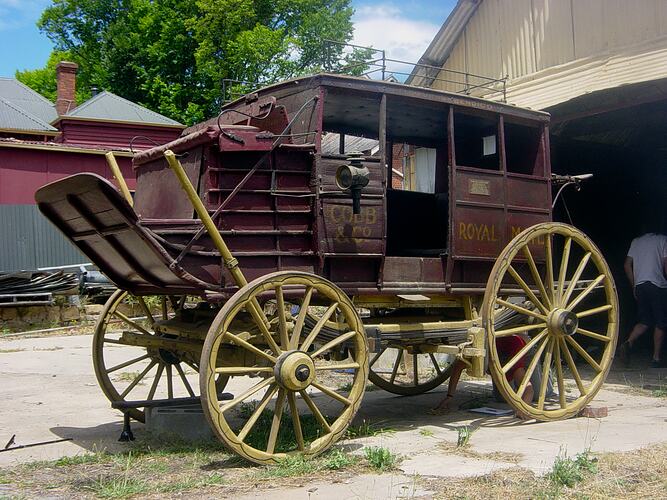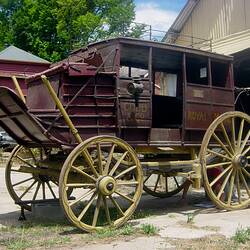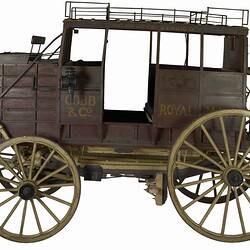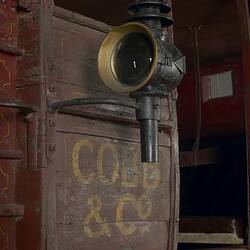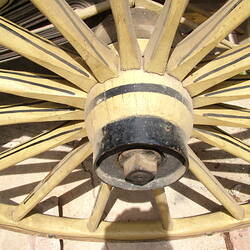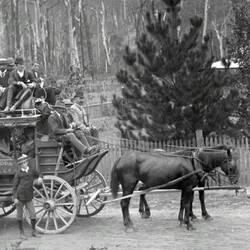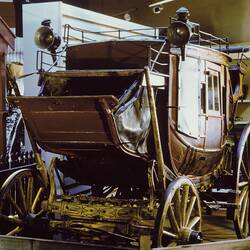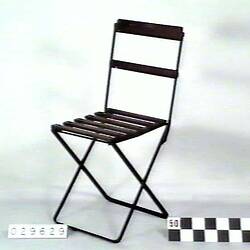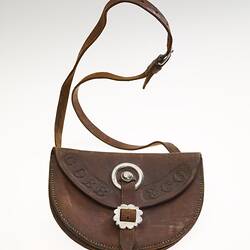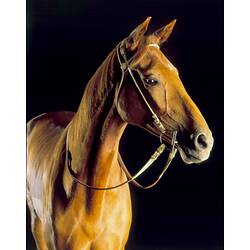Summary
Alternative Name(s): Coach - Rivers-Dickinson.
Horse-drawn Australian pattern 17-passenger stagecoach, with "thorough-brace" suspension, designed to be pulled by four or five horses. The coach has a wooden panelled body with seats for six passengers inside, three on the rear end of the roof facing backwards, three on the front end of the roof behind the driver and an additional two passengers on the bench seat beside the driver. Mail and luggage was carried in a large boot below the driver's and front passengers seat, on a rear luggage rack suspended from the back of the vehicle and on the roof.
Based on early newspaper reports of the coach's history it is believed to have been built in Geelong in about 1880 for the Western Stage Company and spent its working life in western Victoria. The coach has the words "COBB & Co." and "ROYAL MAIL" painted on the lower side body panels and the words "MELBOURNE-BENDIGO" along the top rail above the doors. It is not known how old this sign-writing is, though it predates the 1955 restoration and on one side shows clear evidence of earlier under-writing in a similar style.
The coach was last operated by Mr Thomas Cawker on the Casterton - Mount Gambier route in 1916, being one of the last remaining coaches in regular commercial use in western Victoria. It was then placed in storage and brought to Melbourne a decade later to form a centre piece of celebrations surrounding the opening of the first Melbourne International Motor Show at the Royal Exhibition Building in 1925. For the next 30 years it featured as a prominent part of Melbourne public life, remaining under the care of the Police Department who lent it out for regular use in street parades, demonstration drives and key public events such as the subsequent Melbourne Motor Shows, Victoria's Centenary street parades in 1934 and the launch of the first Holden motor car in 1948. In 1955 the coach was acquired by a Geelong school boy who answered an advertisement placed in a Melbourne newspaper. With assistance from his father and friends he restored the coach before donating it to the National Trust in 1964. It was subsequently displayed by the National Trust first in the Cobb & Co Car Park in Latrobe Street (one of Melbourne's first multi-level carparks) and more recently with the Trust's horse-drawn vehicles collection in Beechworth.
Physical Description
The coach has a wooden panelled body with seats for nine passengers inside, three on the rear end of the roof facing backwards, three on the front end of the roof behind the driver and an additional two passengers on the bench seat beside the driver. Mail and luggage was carried in a large boot below the driver's and front passengers seat, on a rear luggage rack suspended from the back of the vehicle and on the roof. The body, undercarriage and wheels are made from a variety of Australian and imported timbers. The wooden-spoked wheels have iron rims and axles.
Significance
This coach is one of the few surviving horse-drawn vehicles that can claim a direct association with the Victorian operations of the well known "Cobb & Co" coaching enterprise, which had its origins in the Victorian goldrushes of the 1850s and reached its peak during the later decades of the 19th century when a loosely associated group of transport companies operating under the original "Cobb & Co" name were providing a vast network of passenger and mail coach services extending over thousands of miles throughout the eastern mainland states of Australia. By 1870, Cobb & Co coach owners were harnessing some 6,000 horses a day and covering 28,000 miles of road weekly conveying passengers, mail, gold & general parcels to and from country towns in Victoria, New South Wales and Queensland.
Although this coach dates from around 1880, rather than 1854 when the Cobb & Co name was first established by Freeman Cobb and three fellow American immigrants, it is significant because of its connection with the final decades of "Cobb & Co" coach services on Victorian roads and because it represents an important early example of Victorian coach building and coach design. The early success of the Cobb & Co enterprise was based in part on the introduction of a new style of horse-drawn vehicle known as the "thorough-brace" or "jack" coach, characterised by an elegant curved lightweight body suspended on two large leather straps, which helped to isolate the passengers and driver from the jolts and bumps of the rough unmade country roads. Prominent amongst the originators of this style of vehicle was the American firm of Abbott & Downing, based in the small town of Concord, New Hampshire, whose "Concord" thorough-brace coaches played a pivotal role in opening up the American west. When introduced into Australian during the early 1850s, the design also proved to be ideally suited to the rough dirt tracks that initially served as main roads to the Victorian goldfields and outback towns of New South Wales and Queensland. As the network of routes operating under Cobb & Co's "staging" system was expanded, Australian coachbuilders began to supply many of the coaches used, copying the basic Concord design while incorporating a number of modifications to make a distinctive vehicle with a characteristic appearance synonymous with the Australian outback.
This "Cobb & Co" coach is a rare surviving example of an Australian-built thorough-brace coach. It is believed to have been built in Geelong for the Western Stage Coach Company (one of the many firms in Victoria operating under the Cobb & Co banner), in about 1880. Compared with the American-built Abott & Downing "Concord" coach also held by Museum Victoria, this vehicle shows a number of key design differences, including a simpler more square-shaped body that would have been cheaper to build and easier to maintain, a large rigid enclosed front luggage boot and a variation of the original thorough-brace suspension system. While the body of the Concord coach sits directly on leather thorough-brace straps hanging from high metal "jacks" rising well above the front and rear perch bars, this coach has much lower and straighter thorough-braces with turnbuckles for easier adjustment and the flat bottom of the body is mounted on a curved timber and iron cradle or "rocker" which in turn rests on the thorough-braces. This arrangement which became common to most Australian-built Cobb & Co coaches provided a lower centre of gravity, making the coach less likely to overturn on steep or deeply rutted roads, and allowed for the body to be more easily lifted off the thorough-braces for maintenance of the under-carriage.
The coach has additional significance as one of the last coaches to operate commercially under the "Cobb & Co" banner in Victoria and for its subsequent long history of associations with key Melbourne public events and institutions during first half of the 20th century. The coach was last operated by Mr Thomas Cawker on the Casterton - Mount Gambier route in 1916, being one of the last remaining coaches in regular commercial use in western Victoria. It was then placed in storage and brought to Melbourne a decade later to form a centre piece of celebrations surrounding the opening of the first Melbourne International Motor Show at the Royal Exhibition Building in 1925. For the next 30 years it featured as a prominent part of Melbourne public life, remaining under the care of the Police Department who lent it out for regular use in street parades, demonstration drives and key public events such as the subsequent Melbourne Motor Shows, Victoria's Centenary street parades in 1934 and the launch of the first Holden motor car in 1948. In 1955 the coach was acquired by a Geelong school boy who answered an advertisement placed in a Melbourne newspaper. With assistance from his father and friends he restored the coach before donating it to the National Trust in 1964. It was subsequently displayed by the National Trust first in the Cobb & Co Car Park in Latrobe Street (one of Melbourne's first multi-level carparks) and more recently with the Trust's horse-drawn vehicles collection in Beechworth.
More Information
-
Collecting Areas
Information & Communication, Transport, Working Life & Trades
-
Acquisition Information
Transfer from National Trust of Australia (Victoria), Mr Harley Dickinson, 15 Mar 2007
-
Exhibitor
-
Restorer
-
Past Owner
Mr Thomas Cawker, Casterton, Victoria, Australia, circa 1890s-1916
-
Past Owner
Victoria Police Mounted Branch, Victoria Police Barracks, St Kilda Road, South Melbourne, Greater Melbourne, Victoria, Australia, circa 1926-1954
-
User
Western Stage Coach Co., Geelong, Victoria, Australia, circa 1880-1890s
-
Inscriptions
The coach has the words "COBB & Co." and "ROYAL MAIL" painted on the lower side body panels and the words "MELBOURNE-BENDIGO" along the top rail above the doors. It is not known how old this sign-writing is, though it predates the 1955 restoration and on one side shows clear evidence of earlier under-writing in a similar style.
-
Brand Names
-
Classification
-
Category
-
Discipline
-
Type of item
-
Overall Dimensions
4290 mm (Length), 2050 mm (Width), 2590 mm (Height), 800 kg (Weight)
Approximate weight only.
-
Keywords
Coaches, Goldfields, Horsedrawn Vehicles, Postal Services, Road Transport
